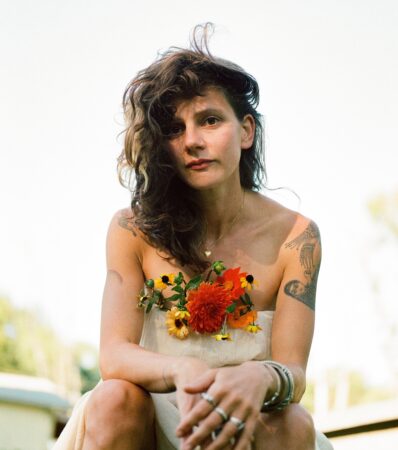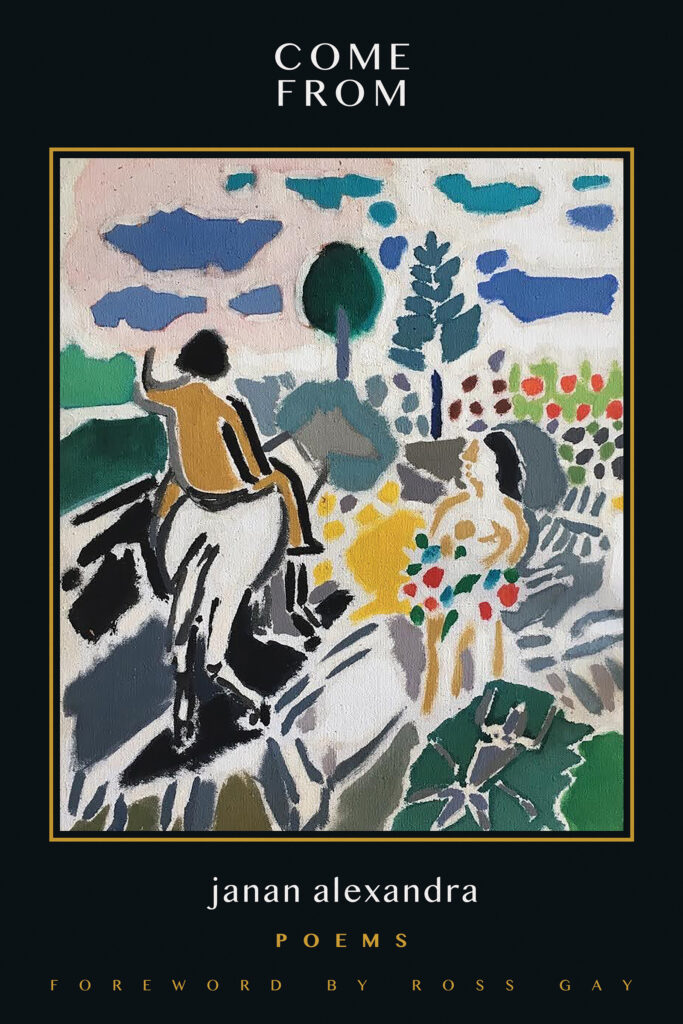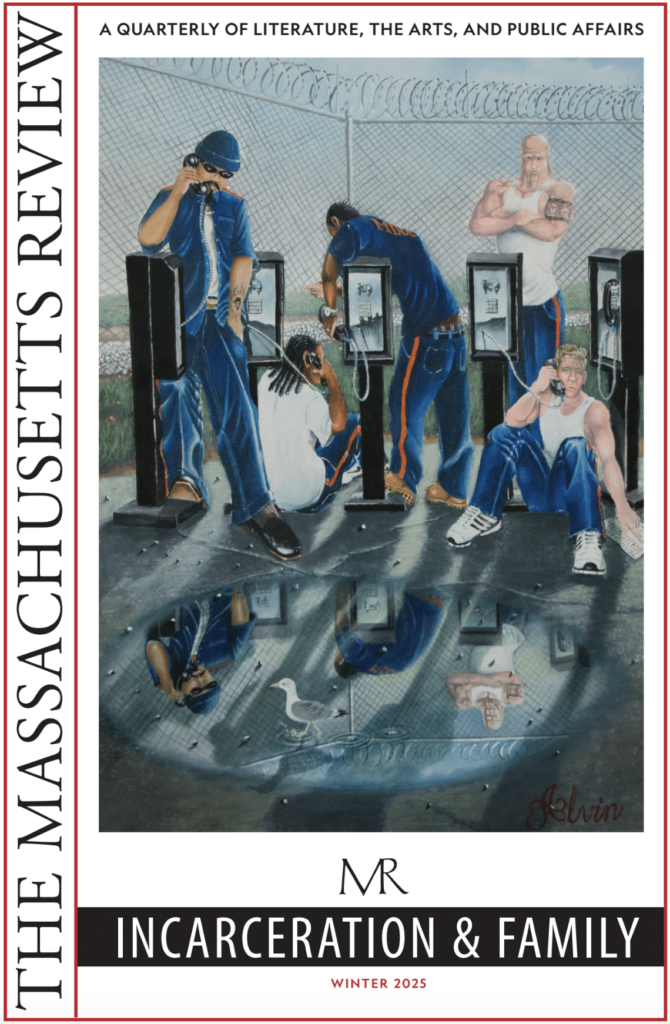10 Questions for janan alexandra

On Saturday two men came to slaughter the palm, whose exuberant pinnate leaves I had made a habit of watching each morning from my post inside the bedroom, head cocked on the pillow. My Observation of the palm’s swaying became a course in breathing, a crown of exemplary lungs to follow, learning like this to breathe through imitation, as with all things, absorbing this slowly.
—from janan alexandra’s “[tell me what you know about dismemberment],” Volume 66 Issue 2 (Summer 2025)
Tell us about one of the first pieces you wrote.
This got me thinking back to some of my very earliest poems, which I wrote as a teenager. And actually when I was a senior in high school I was awarded a not insignificant amount of money from the National Foundation for the Advancement of the Arts for precisely some of these early poems, which was maybe my first inkling, against all odds, that you could write poems and make a life doing that.
Of course these first poems are kind of not great, or whatever, they’re poems I wrote when I was seventeen. But there was one about my mom and specifically about my fear of losing my mom young because she had lost her mom young. She was nineteen when her mother Helly died and as a kid I was haunted by this knowledge and very afraid that I would experience that same loss. And I think I thought that there was no way I could survive something like that. So I wrote this poem. Partly to honor how courageous and complex my mother was/is, to celebrate her survival, and partly from my need to understand how we each persist.
And the poem began with an epigraph by Khalil Gibran, something about being stronger than our scars. Heavy stuff. It went straight down the page in one long stanza, and it was called “Nineteen.” So in many ways not much has changed: still write about my mom a lot, or toward my mom, still struggle with titles!
What writer(s) or works have influenced the way you write now?
This is such a beautiful and beloved question. Let me count the ways! Here’s a ballpark list in no particular order:
Well, the poem that began my life in poems, my long love of poems (and my love of long poems) when I was just fifteen years old, thanks eternal, was TS Eliot’s “The Love Song of J. Alfred Prufrock.” The music of that poem is encoded and imprinted into my own language, probably forever.
I would not be the writer I am today without the books and teachings and voices and dreaming of Aracelis Girmay, Carolina Ebeid, Ross Gay, Ellen Doré Watson, Joan Larkin, Kevin Quashie, Annie Boutelle, Jean Valentine, Dan Beachy-Quick, Adrian Matejka, Cathy Bowman, Stacey Lynn Brown, and many more from whom I’ve learned so much about life and writing.
And plenty of other writers alongside those named above. I’ll try not to rattle off my entire bookshelf but here are the heavy hitters that are among my earliest and most enduring influences: Arundhati Roy, Toni Morrison, June Jordan, Steve Scafidi, W.S. Merwin, Zadie Smith, Etel Adnan, Lucille Clifton, Gabrielle Calvocoressi, Louise Glück, Paul Celan, Raúl Zurita, Terrance Hayes, Anne Carson, Rachel Cusk, Roger Reeves, Brian Dillon, Jean Saïd Makdisi, Naomi Shihab Nye, Steven Salaita, Lucie Brock Broido, Brigit Pegeen Kelly, Gwendolyn Brooks, Mahmoud Darwish, Bhanu Kapil, Fanny Howe, Annie Dillard, Solmaz Sharif, CA Conrad, Marie Howe, Thomas Lux, Sharon Olds, Walt Whitman, probably Emily Dickinson too, in ways I can’t exactly explain.
What other professions have you worked in?
I’ve packaged sunglasses, filled seed orders at FEDCO, taught yoga and movement classes, nannied for families, cooked at restaurants and cafes, welded ice cream scoops, tied oyster nets, tended land and animals, built (fairly basic) furniture, shaped and baked very high volumes of bread, painted houses, once—not for very long—worked in retail at a clothing boutique, and busked (still busk) fiddle tunes with my partner Logan to make a living.
What did you want to be when you were young?
I don’t think I know the answer to this question. Or maybe the idea of “what I want to be when I grow up” didn’t feel like part of my inner life in such a straightforward way. I do remember “playing teacher” when I was very young and I loved that (I even had a little black chalkboard and an overhead projector I had salvaged from somewhere!). Which is so sweet because you know, now, I really am a teacher. For pay and play.
I also “played library” and other things in that vein—things to do with paper and pens and printed matter. I liked all the tactile stuff of offices and desk drawers. At one point I really thought working at a post office or a bank would be the most fun because of all the office supplies I’d get to use. And the stamping and sealing and clicking. Tape and paperclips and staplers and such.
I guess at some point I must have also wanted to be a violinist because I got it in my head to start playing the violin when I was around 8 or 9 years old, which is mostly not all that fun in the beginning and is actually probably one of the most unforgiving instruments of all time, and so predictably I quit before I really got anywhere. But then I started up again in my twenties and though I’m not at all a career musician I’m a very devoted student of the violin and identify strongly with my music practice. And being a musician has brought so much to my writing.
Certainly as a teenager the idea of being a writer was in me somewhere and my interest in literature and art and radical imagination was nurtured by my family and my teachers. And you know, as a student at Smith College (just down the road from y’all) I got to witness a really vibrant life in poetry through my work at the Poetry Center. So I had a lot of good models. Which is such a gift. But still, that notion of knowing where I wanted to go or having a goal in mind, that wasn’t there. I wanted to explore. I wanted to live deeply and fully. I wanted to love and be loved and be useful and be alive to the world. Those were the big aspirations, however I got there didn’t matter much to me. That said, by the time I graduated from college and spent a few years moving around and getting a little lost, poems were the one thing that remained. I didn’t really have a choice. Ultimately, the need to write was out of my hands. So maybe around that time, in my mid-twenties, I said well this has to be the center of my life around which all else moves. And so it has been. The circumference and the singing.
What inspired you to write this piece?
The answer to this is pretty much embedded in the poem, which more or less wrote itself while I was living in Cyprus and had developed a particular relationship—that is, a great affection and intimacy, even—with the palm trees and other flora/fauna around us. Including one palm tree that I could see through the bedroom window while lying in bed each morning. One day some guys came and cut that palm tree down and I was sort of heartbroken. I mean, who knows, maybe it was the “right” thing to do, I’m not an arborist or a city planner. But it felt like such a violence, such an indecent deracination and assault on life. And the sound of the chainsaw is just horrible. And you know, even as a kid peeling cucumbers for my mom I always used to wince as I peeled them, thinking about how it might hurt them. So I guess this sensitivity to all living beings is a real part of my inner world, it’s part of my skin. And as the editors at The Massachusetts Review deftly point out in the introduction to the Summer Issue, the poem and especially its invocation of “October” becomes inextricable from genocide, ecocide, and other brutal policies of removal and ethnic cleansing that are unrelenting right now.
Another occasion for this poem is in the title “[tell me what you know about dismemberment]” which comes directly from Bhanu Kapil’s list of 12 questions in her book, The Vertical Interrogation of Strangers. These 12 questions are incredibly powerful and probing and lyrical, almost immediately inviting us into a poetic register. I find myself writing and teaching to these questions all the time.
Is there a city or place, real or imagined, that influences your writing?
To some extent where I am always influences my writing. I’m sensitive to my immediate conditions, and the physical world around me tends to enter my work. Partly as a matter of attentiveness and relationship, or attunement to the ecosystem, landscape, community, and atmosphere wherever I am.
I’m also often writing toward Lebanon and the Arab world more broadly as a Lebanese American poet in diaspora. I write toward both the roots and fractures of my family’s dislocation. The longing for return is omnipresent, so that’s a big force in my work and in my poetic imagination.
I like the idea of an ‘imagined place’ influencing my writing, too. Yes. I think that imagined place is the place of dreaming, the way that we write toward our precise and (im)possible utopias, another way of saying, toward a place that can hold all of us. In his amazing second collection of poems, Bringing the Shovel Down, Ross Gay has a poem called “Love, Here’s the Deal.” He ends the poem with these lines:
Somewhere there’s a road.
Some of us are going to find it.
You can come if you want.
That’s the imagined place that influences my writing, and it’s actually not all that imagined. It’s a real place. We might call it the field of mutuality. Or, the circle of brokenhearted time. Or, standing in line at the grocery store and chatting with your neighbors. Or, sharing your food with somebody. It’s the steady waters of mutual regard that are everywhere in our midst.
Do you have any rituals or traditions that you do in order to write?
I tend to write first thing in the morning and go for as long as I can. Sometimes that might be 20 minutes, other times it’s a couple of hours. I write by hand in unlined notebooks, typically. I love a good pilot G-2 05 ink pen, or even the 0.38s are great. Nothing too heavy or thick otherwise it bleeds through the other side and that gets tough to decipher and bruised looking. What else? Eventually I get to transcribing onto MS Word, sometimes turning prose into poems, other times lifting single lines like little scraps of cloth I’m stitching together, other times going straight into an essay. And I label my notebooks with the date on the spine in gold sharpie, which is a kind of obsessive thing to do but it makes it easier to go back and find stuff later!
Other rituals: a lot of reading!! Note taking. Listening to David Naimon’s incredible interviews with writers on his Tin House show, “Between the Covers” – the literary podcast to end all podcasts. I do put my printed work up on the walls because that always seems smart and kind of cool to me, but I’m not sure how helpful it is if I’m not in the sequencing/arranging/ordering stage. Putting manuscripts together is such a peculiar and big task to me, so I do find that it helps to have plenty of space to lay things out. That’s a nice ritual when the time is right.
Other traditions and rituals: being a total chaos muppet on the computer. My computer organization is rubbish, which is sort of funny and surprising given how fastidious I am about organization and tidiness in my physical spaces. So I guess that’s part of my writing process/practice—having ten different versions of the same poem titled differently and saved in different places. Somehow I manage.

If you could work in another art form what would it be?
Dance for sure. When I was a student at Smith College I had the great good fortune of working with some truly incredible dancers and dance teachers in the Pioneer Valley, especially in the modern/contemporary and contact improvisation community. I mean everything begins and ends in the body. Movement and touch are such forces of expression and expressivity. Articulation. And we live in a pretty disembodied culture here in the USA, at least in the mainstream spheres. Especially writers. We don’t even know what we’re feeling or where we’re feeling it in our bodies half the time! Yes dance, movement for sure.
But also sculpture! I’ve always collected little items and taken photos of shapes and color compositions that catch my eye and made little altars out of rocks and bones and feathers and stuff. Pressed flowers. Special leaves. And as a writer I really like stitching tatters together, putting things next to each other and seeing how they sing. I think that working as a sculptor would open up so much space for me. Volume, scope, size, material, color, texture. Creating sculptures or structures, that feels very poem-adjacent to me. What a poem can hold. What a sculpture can hold. They’re both spaces of interaction, sites of connection. I suppose all art is. But something about the idea of what a poem/sculpture can hold. How these forms might be able to hold us, and to hold our stories, and to hold our living far longer than our bodies can. Gives me goosebumps just thinking of it.
What are you working on currently?
I tend to work on many projects at the same time, a trick I learned from a friend who is a fabulous painter. We used to co-work in their studio and I would watch them stretch and gesso a bunch of canvases and then move around from piece to piece, working simultaneously on all of them. This method is wonderful for poems, I find. In terms of more concrete particulars about what’s cooking—I’m working on a book about sisterhood, silence, and estrangement; I’m working on a book about loss and grief; and I’m working on a book that is interested in the work of writing in a time of genocide, which, of course, it has pretty much always been a time of genocide—that is, there has been no time without extraordinary catastrophe and atrocity—while simultaneously always being a time of beauty. Maybe the book is about solidarity, certainly the work is connected to Gaza and the Palestinian struggle more broadly and my own roots in Lebanon. I think of Nina Simone saying that the role of the artist is to reflect the times they are living in. And I think about the persistence of life and beauty and care no matter what. I think that’s one piece of the work for sure. And maybe all of these books are actually one book? We’ll see. I also have some essays in my drawer, by which I mean in my computer, not sure exactly where they fit or what sort of larger thing they might be part of, but I love writing essays. They’re so fun and capacious and through them I can access a different voice, an equally beloved voice, to the voices in my poems.
What are you reading right now?
Oh, I’m reading a dozen books at once. It’s summer, after all. (Though every season is good for reading, isn’t that lucky?) I just finished Diana Khoi Nguyen’s unforgettable first collection of poems, Ghost Of and am now onto her second, Root Fractures. I’m also savoring Dionne Brand’s A Map to the Door of No Return: Notes to Belonging, along with Jenny Erpenbeck’s strange and marvelous Visitation and a couple of essays each day from Eliot Weinberger’s An Elemental Thing. On my bedside table right now are Lena Khalaf Tuffaha’s National Book Award Winning poetry collection, Something About Living, and Anne Carson’s Wrong Norma, and I also just got my copy of Heaven Looks Like Us—the treasure trove of Palestinian poetry that George Abraham and Noor Hindi just put out with Haymarket Books. Which I need, which we all need. I can’t wait to read Steve Scafidi’s newest book, The Appalachian Sea, I think it just came out. And Aracelis Girmay’s fourth book of poems, coming this fall, praise be, great great news for the earth: GREEN OF ALL HEADS.
JANAN ALEXANDRA is the author of the poetry collection COME FROM (BOA Editions, 2025). She teaches Creative Writing at Indiana University and in community spaces, edits poetry for The Rumpus, and helps curate Mondays Are Free, a Substack collaboration between poets Ross Gay and Pat Rosal.



